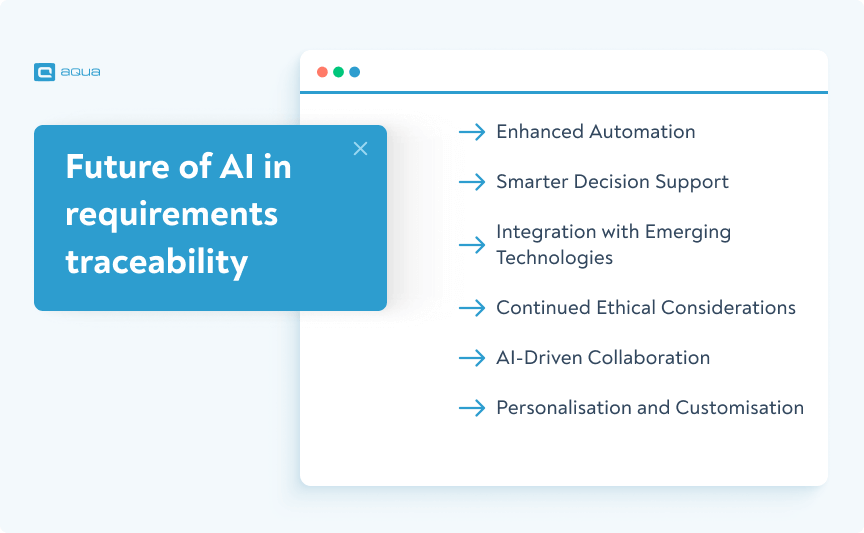Key Benefits of Integrating AI to Requirement Traceability
Before we delve into AI requirements traceability, let’s define the concept first. Requirement traceability involves linking and managing requirements across various stages of development to ensure the final product aligns with initial expectations. It is about building a roadmap for a project, ensuring every step in the journey—from the initial idea to the final product—stays on track. However, it’s not an easy road to navigate. Imagine having a hundred different puzzle pieces, each representing a requirement, and trying to fit them together as the project progresses. This process gets even trickier when these pieces keep changing shape and size.
“The most difficult part of requirements gathering is not recording what the user wants; it is the exploratory development activity of helping users figure out what they want.”
This is where AI steps in, saving time, ensuring accuracy, and catching changes that could easily slip through manual monitoring. Sounds too generic? Here is how integrating AI with requirement traceability will benefit you, specifically:
- Automated Traceability: AI can make your life easier by automating the tracking of requirements across different stages of development. This means less manual effort on your part and fewer chances of errors when linking requirements to their respective elements like test cases or code changes.
- Change Impact Analysis: When requirements change, AI helps you quickly understand how it impacts the project. It’s like having a fast assistant that assesses these changes swiftly, allowing you to adapt and respond faster without spending hours figuring out the implications. According to a case study by Accenture, integrating AI for impact analysis reduces the time spent assessing changes by 70%.
- Enhanced Visibility and Reporting: With AI-powered requirement management tools, you gain real-time visibility into requirement coverage. Using AI algorithms, these tools analyse project elements like code and test cases, offering straightforward insights into the status of each requirement. This enhanced visibility ensures that project teams and stakeholders can quickly assess the alignment between development efforts and defined requirements. Additionally, the tools generate dynamic reports, keeping everyone informed about the current state of requirement coverage, facilitating more informed decision-making in the QA process.
Regarding requirements management and traceability, what could be a better solution than aqua cloud? With aqua’s AI-powered capabilities, you effortlessly see how your tests cover requirements and match each one to its perfect test counterpart. Generate detailed reports, share progress with stakeholders in any format you prefer, and prioritise your backlog using tailored boards for requirements, defects, and test cases—whether you’re a Kanban enthusiast or follow a Waterfall approach. Streamline QA planning with Scrum boards designed explicitly for test cases, ensuring meticulous organisation within sprints or dedicated QA cycles. Engage in centralised discussions, review, collaborate, provide feedback, and approve requirements—all within aqua’s collaborative hub. Turn requirement management into a triumph with aqua cloud.
Achieve 100% traceability with aqua cloud
Best practices for requirement traceability using AI
Now that you know the benefits AI brings, what are the requirement traceability best practices? How can you implement AI into the process perfectly? Here is your step-by-step guide:
- Clear Requirement Identification: Start by ensuring clear and well-defined requirements. AI thrives on clarity, so the better you define your needs, the more effectively AI can trace and manage them.
- Implement Robust AI Tools: Choose AI-powered tools like aqua cloud, which specialises in requirement traceability. Look for automation features that link requirements across development stages, ensuring accuracy and efficiency.
- Regularly Update and Monitor: Keep requirements updated and monitored regularly. AI can help continuously track and link as requirements evolve throughout the project.
- Data Quality and Consistency: Maintain high-quality data for AI analysis. Consistency in data formatting and input improves AI’s ability to link and trace requirements accurately.
- Team Training and Collaboration: Train teams to effectively use AI tools for requirement traceability. Encourage collaboration and communication to leverage AI insights for better decision-making.
As long as you follow these best practices, you can maximise AI’s power in requirements management and traceability. But you might ask, does it guarantee a flawless, 100% efficient process with no challenges? The answer is no, which we clarify in the next part.
Potential challenges and overcoming them
Although the process has its challenges, you have no reason to fear as you can overcome each one of them. Here is a detailed breakdown of the challenges of requirements traceability with artificial intelligence:
1. Data Quality and Consistency: Inconsistent or poor-quality data, such as missing or false information in requirements documentation, harms AI’s ability to link and analyse data effectively. For instance, ambiguous or outdated requirements can lead to incorrect associations and misinterpretations by AI algorithms.
Solution: Implement solid data validation processes, conduct regular audits, and establish data cleaning protocols to ensure data integrity before AI analysis. You enhance AI’s ability to make accurate associations and traceability mappings by standardising formats, verifying accuracy, and regularly updating requirements.
2. Complexity of Integration: Integrating AI tools seamlessly into existing workflows can disrupt established processes. It can cause resistance or inefficiencies due to unfamiliarity or conflicting systems. For instance, incompatible interfaces or resistance to change among team members can hinder smooth integration.
Solution: Start with small-scale implementations, providing extensive training and phased integration to minimise disruption. Offer comprehensive support and clear communication to help teams adapt gradually, ensuring a smoother transition without compromising existing workflows.
3. Overreliance on AI: Excessive dependence on AI without human oversight can lead to blind trust in AI-generated results, potentially missing nuanced or context-specific requirements. This overreliance might lead to overlooking critical details or misinterpretation of requirements.
Solution: Maintain a human-AI balance by encouraging collaboration and incorporating manual validation. Foster an environment where AI insights are cross-validated by experienced team members to ensure comprehensive and accurate requirement interpretations.
4. Costs and Resource Allocation: The initial investment and allocation for AI implementation pose financial constraints or divert resources from other critical areas. It could lead to budgetary concerns or resistance from stakeholders due to high upfront costs.
Solution: Conduct comprehensive cost-benefit analyses, showcasing long-term efficiency gains and reduced manual effort to justify the initial investment. Efficient resource management and clear communication regarding the benefits of AI implementation can align stakeholders towards long-term advantages.
5. Adaptation and Training: Training teams to proficiently use AI tools for requirement traceability might require significant time and effort, potentially causing resistance or slowing down productivity during the learning curve.
Solution: Invest in extensive training programs, workshops, and ongoing support to facilitate a smooth transition. Encourage a culture of continuous learning to ensure teams adapt comfortably and efficiently to AI-powered tools.
6. Security and Privacy Concerns: AI systems handling sensitive data pose security and privacy risks if not adequately protected, potentially leading to breaches or non-compliance with data regulations.
Solution: Implement robust cybersecurity measures, encryption protocols, and compliance frameworks to safeguard data. Ensure strict adherence to regulatory standards and protocols to mitigate security risks and protect sensitive information handled by AI systems.
By addressing these challenges with comprehensive solutions, you’ll be better equipped to navigate the complexities of AI-powered requirement traceability effectively.
Future of AI in requirements traceability
Now, the question arises: what lies ahead? Where are we headed with AI in requirements management? AI will likely become more ingrained in software development and QA processes as technology evolves, reshaping how we handle requirements. Here’s the list of predictions based on how the progress of AI has evolved in recent years:
- Enhanced Automation: AI will continue streamlining requirement traceability, automating more intricate tasks. Expect AI to delve deeper into understanding natural language, enabling more sophisticated linking and analysis of requirements across diverse development stages.
- Smarter Decision Support: AI-driven analytics will evolve, providing predictive insights into the potential impact of requirement changes. This foresight will empower you to make informed decisions earlier in the development cycle, mitigating risks and optimising resource allocation.
- Integration with Emerging Technologies: AI will fuse with emerging technologies like augmented reality (AR) and virtual reality (VR), transforming how requirements are visualised and understood. This integration could revolutionise requirement communication and comprehension among cross-functional teams.
- Continued Ethical Considerations: As AI plays a more significant role, ethical considerations regarding bias, privacy, and transparency will become increasingly vital. Expect a continued focus on ethical AI practices in requirement traceability to ensure fairness and compliance.
- AI-Driven Collaboration: AI will facilitate seamless collaboration among global and remote teams, offering real-time insights and enabling effective communication on requirement changes and their implications.
- Personalisation and Customisation: AI’s adaptability will enable personalised requirement traceability tools tailored to specific project needs, catering to varying methodologies and industries.

For now, let’s focus on what AI-powered tools already do, shall we? With the right tool, you’ll effortlessly align tests with requirements, generate comprehensive reports tailored to your preferences, and prioritise your backlog using boards designed for your methodology, be it Kanban or Waterfall. You’ll also effortlessly transform user inputs or text into precise, crystal-clear requirements like PRDs and User Stories. Can you do all that with one tool? Of course, you can; it is called aqua cloud! With aqua, you’ll also engage in focused QA planning with dedicated Scrum boards for test cases and enjoy centralised collaboration, where reviews, feedback, and approvals seamlessly converge—all within aqua cloud’s collaborative hub. Do not sweat over requirements management problems: let aqua do everything for you.
Experience the triumph of 100% traceability







